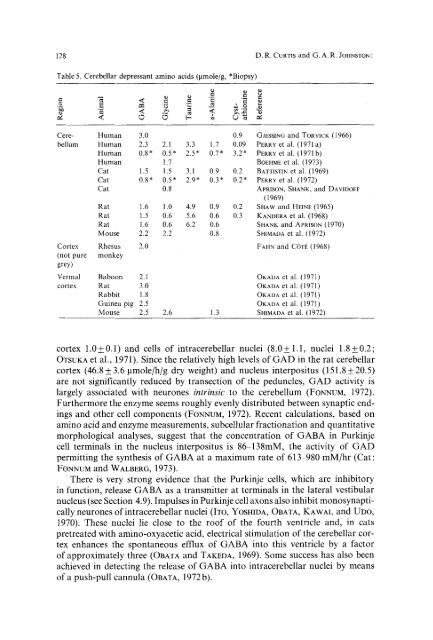Amino acid transmitters in the mammalian central nervous system
Amino acid transmitters in the mammalian central nervous system
Amino acid transmitters in the mammalian central nervous system
You also want an ePaper? Increase the reach of your titles
YUMPU automatically turns print PDFs into web optimized ePapers that Google loves.
128 D.R. CURTIS and G. A. R. JOHNSTON :<br />
Table 5. Cerebellar depressant am<strong>in</strong>o <strong>acid</strong>s (p.mole/g, *Biopsy)<br />
Cerebellum<br />
Cortex<br />
(not pure<br />
grey)<br />
Vermal<br />
cortex<br />
Human 3.0 0.9 GJESSING and TORViCK (1966)<br />
Human 2.3 2.1 3.3 1.7 0.09 PERRY et al. (1971 a)<br />
Human 0.8* 0.5* 2.5* 0.7* 3.2* PERRY et al. (1971 b)<br />
Human 1.7 BOEHME et al. (1973)<br />
Cat 1.5 1.5 3.1 0.9 0.2 BATTISTIN et al. (1969)<br />
Cat 0.8* 0.5* 2.9* 0.3* 0.2* PF, RRV et al. (1972)<br />
Cat 0.8 APRISON, SHANK, and DAVlDOFF<br />
(I969)<br />
Rat 1.6 1.0 4.9 0.9 0.2 SHAW and HEINE (1965)<br />
Rat 1.5 0.6 5.6 0.6 0.3 KANDERA et al. (1968)<br />
Rat 1.6 0.6 6.2 0.6 SHANK and APRISON (1970)<br />
Mouse 2.2 2.2 0.8 StatMADA et al. (1972)<br />
Rhesus 2.0 FAHN and C6T~ (1968)<br />
monkey<br />
Baboon 2.1 OKADA et al. (1971)<br />
Rat 3.0 OKADA et al. (1971)<br />
Rabbit 1.8 OKADA et al. (1971)<br />
Gu<strong>in</strong>ea pig 2.5 OKADA et al. (1971)<br />
Mouse 2.5 2.6 1.3 SHIMADA et al. (1972)<br />
cortex 1.0+0.1) and cells of <strong>in</strong>tracerebellar nuclei (8.0+_1.1, nuclei 1.8+0.2;<br />
OTSUKA et al., 1971). S<strong>in</strong>ce <strong>the</strong> relatively high levels of GAD <strong>in</strong> <strong>the</strong> rat cerebellar<br />
cortex (46.8 + 3.6 gmole/h/g dry weight) and nucleus <strong>in</strong>terpositus (151.8_+20.5)<br />
are not significantly reduced by transection of <strong>the</strong> peduncles, GAD activity is<br />
largely associated with neurones <strong>in</strong>tr<strong>in</strong>sic to <strong>the</strong> cerebellum (FONNUM, 1972).<br />
Fur<strong>the</strong>rmore <strong>the</strong> enzyme seems roughly evenly distributed between synaptic end<strong>in</strong>gs<br />
and o<strong>the</strong>r cell components (FONNUM, 1972). Recent calculations, based on<br />
am<strong>in</strong>o <strong>acid</strong> and enzyme measurements, subcellular fractionation and quantitative<br />
morphological analyses, suggest that <strong>the</strong> concentration of GABA <strong>in</strong> Purk<strong>in</strong>je<br />
cell term<strong>in</strong>als <strong>in</strong> <strong>the</strong> nucleus <strong>in</strong>terpositus is 86 138mM, <strong>the</strong> activity of GAD<br />
permitt<strong>in</strong>g <strong>the</strong> syn<strong>the</strong>sis of GABA at a maximum rate of 613 980 mM/hr (Cat:<br />
FONNUM and WALBERG, 1973).<br />
There is very strong evidence that <strong>the</strong> Purk<strong>in</strong>je cells, which are <strong>in</strong>hibitory<br />
<strong>in</strong> function, release GABA as a transmitter at term<strong>in</strong>als <strong>in</strong> <strong>the</strong> lateral vestibular<br />
nucleus (see Section 4.9). Impulses <strong>in</strong> Purk<strong>in</strong>je cell axons also <strong>in</strong>hibit monosynaptically<br />
neurones of<strong>in</strong>tracerebellar nuclei (ITO, YOSHIDA, OBATA, KAWAI, and UDO,<br />
1970). These nuclei lie close to <strong>the</strong> roof of <strong>the</strong> fourth ventricle and, <strong>in</strong> cats<br />
pretreated with am<strong>in</strong>o-oxyacetic <strong>acid</strong>, electrical stimulation of <strong>the</strong> cerebellar cortex<br />
enhances <strong>the</strong> spontaneous efflux of GABA <strong>in</strong>to this ventricle by a factor<br />
of approximately three (OBATA and TAKEDA, 1969). Some success has also been<br />
achieved <strong>in</strong> detect<strong>in</strong>g <strong>the</strong> release of GABA <strong>in</strong>to <strong>in</strong>tracerebellar nuclei by means<br />
of a push-pull cannula (OBATA, 1972 b).













